How to Connect: Sonos Playbar Hi-Fi Sound User Guide
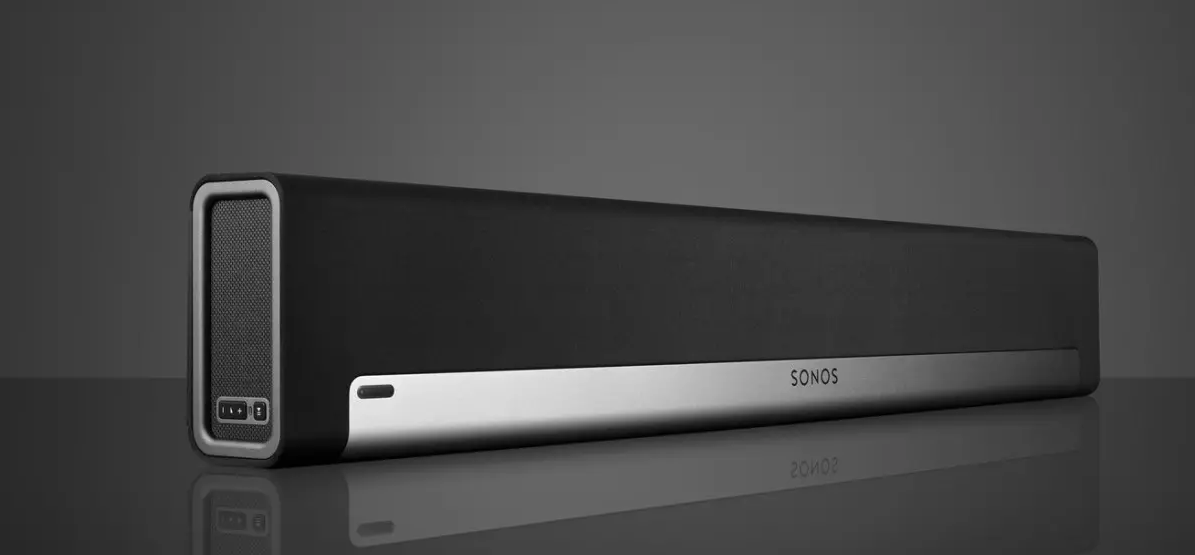
Content
Introduction
The Sonos Playbar Hi-Fi Sound is a premium soundbar designed to elevate your home audio experience, delivering exceptional sound quality for both music and movies. With its sleek design, the Playbar integrates seamlessly into any entertainment setup, featuring nine speakers that produce rich, immersive audio. It connects effortlessly to your TV and can be expanded with additional Sonos speakers for a complete surround sound experience. Priced at approximately $699, the Playbar is an ideal choice for audiophiles seeking superior sound performance.
Sonos PLAYBAR
Flood any room with epic, full-theater HiFi sound and wirelessly stream all the music on earth through one easy-to-use player.
- Sophisticated 9-speaker design
- Connects to your TV using a single optical cable and plays everything that's connected to the TV, including cable boxes and game consoles
- Can be placed flat on a TV stand or mounted horizontally above or below the TV
- Compatible with Dolby Digital and stereo
It takes just a few minutes to get your PLAYBAR up and running—turn to page 1 to get started. Once you’ve got it set up, you can add additional Sonos products any time.
Note: One Sonos product must be connected to your broadband router. If the PLAYBAR will not be located near your router, you can connect a Sonos BRIDGE or any Sonos player (purchased separately) to the router instead.
What’s in the Box
- Sonos PLAYBAR
- Power Cord
- 5 ft. /1.5m TOSLINK Optical Audio Cable
- Ethernet Cable
- Quick Start Guide
- Important Product Information Booklet
What’s Required
Television requirements
The PLAYBAR is compatible with any television that has an optical digital audio output.
Home network requirements
Note: Your network must have a high-speed Internet connection, as the Sonos system is designed to provide you with free, online software updates. Your Sonos system must be registered to receive these updates so be sure to register during the setup process. We do not share your e-mail address with other companies.
- High-speed DSL/Cable modem, or fiber-to-the-home broadband connection for proper playback of Internet-based music services. (If your Internet service provider only offers Satellite Internet access, you may experience playback issues due to fluctuating download rates.)
- If your modem is not a modem/router combination and you want to take advantage of Sonos' automatic online updates, or stream music from an Internet-based music service, you must install a router in your home network. If you do not have a router, purchase and install one before proceeding. If you are going to use the Sonos Controller App on an Android™ or iOS device, or you are setting up Sonos wirelessly, you will need a wireless router. Please visit our Web site at http://faq.sonos.com/apps for more information.
Note: Sonos communicates over a 2.4GHz home network supporting 802.11 b/g wireless technology. 5GHz networks are not supported in a completely wireless Sonos setup.
- Connect a Sonos BRIDGE, BOOST or player to your router if:
- You have a larger home where the WiFi performance isn’t reliable and you want to strengthen the wireless performance of your Sonos system.
- Your WiFi network is already in high demand with streaming video and web surfing and you want to create a separate wireless network exclusively for your Sonos speakers.
- You want to pair a SUB™ and/or a pair of PLAY:1 or PLAY:3 speakers with your PLAYBAR to create a 3.1 or 5.1 home theater setup.
- Your home network is 5GHz only (not switchable to 2.4GHz).
- For best results, you should connect the computer or NAS drive that contains your personal music library collection to your home network router using an Ethernet cable.
PLAYBAR Specifications
| Feature | Description |
|---|---|
| Audio | |
| Amplifier | Nine Class-D digital amplifiers perfectly tuned to match the speakers and acoustic architecture. |
| Speakers | Nine amplified speakers—six midrange and three tweeters. PLAYBAR’s automatic equalization means the system self-adjusts for rich, seamless performance. |
| 3.0 Home Theater | PLAYBAR’s nine-speaker design plunges you into the cinematic action with huge waves of sound that capture every whisper and footfall. The player connects to your TV with a single cable and plays all sources, including satellite boxes and game consoles. |
| 3.1 Home Theater | Pair PLAYBAR with SUB, and with the push of a button you get spine-curling bass to your cinematic experience—wirelessly. |
| 5.1 Home Theater | Add PLAY:1 or PLAY:3 speakers to your PLAYBAR and SUB for a true surround sound experience. Sleek and understated with wireless control, this deeply immersive home theater experience wraps you in crystal-clear, state-of-the-art Sonos sound. |
| System Requirements | TV with optical audio output, broadband Internet, one Sonos product wired to router, and a Sonos Controller App. |
| Music | |
| Operating systems (for stored files) | Window XP SP3 and higher; Mac OS X v10.6.8 and higher; NAS (Network Attached Storage) devices supporting CIFS |
| Music Services Supported | Sonos works seamlessly with 7 Digital, 8 Tracks, Amazon Cloud Player, AUPEO!, Batang, Beats Music, blinkbo music, Calm Radio, Concert Vault, Dar.fm Record Radio, Daytrotter, Deezer, Douban, Spotify, and others, offering DRM-free tracks (service availability varies by region). |
| Internet Radio Supported | Streaming MP3, WMA |
| Audio Formats Supported | Support for compressed MP3, iTunes Plus, WMA (including purchased Windows Media downloads), AAC (MPEG4), AAC+, Ogg Vorbis, Audible (format 4), Apple Lossless, Flac (lossless) music files, as well as uncompressed WAV and AIFF files. Native support for 44.1kHz sample rates. Additional support for 48kHz, 32kHz, 24kHz, 22kHz, 16kHz, 11kHz, and 8kHz sample rates. Note: Apple “Fairplay”, AAC Enhanced and WMA Lossless formats not currently supported. Previously purchased Apple “Fairplay” DRM-protected songs may be upgraded. |
| Album Art Supported | JPEG, PNG, BMP, GIF |
| Playback Modes | Crossfade, shuffle, repeat |
| Playlists Supported | iTune, WinAmp Windows Media Player, and MusicMatch (.m3u, .pls, .wpl) |
| Networking | |
| Ethernet Port (2) | A single Ethernet port can connect PLAYBAR to a wired home network. A second Ethernet port can be used to share the network connection with other devices in your network. |
| Wireless Connectivity | Works on your home WiFi network with any 802.11b/g, 2.4GHz broadcast capable router Also works on SonosNet™, a secure AES encrypted, peer-to-peer wireless mesh network dedicated exclusively for your Sonos system to reduce WiFi interference. |
| SonosNet Extender | Functions to extend and enhance the power of SonosNet 2.0 |
| General | |
| Side Panel Buttons | Volume Up, Volume Down, and Mute |
| Side Panel LEDs | Indicates PLAYBAR status |
| Power Supply | 100 - 240 VAC, 50/60 Hz, auto-switchable |
| Dimensions (H x W x D) | 3.35” (H) x 35.43” (W) x 5.51” (D), 85mm (H) x 900mm (W) x 140mm (D) |
| Weight | 11.9 lbs (5.4kgs) |
| Operating Temperature | 32°F to 104°F (0°C to 40°C) |
| Storage Temperature | 4°F to 158°F (-20°C to 70°C) |
| Package Contents | PLAYBAR, AC power cord, optical audio cable, quickstart guide, and legal booklet |
| Multiple Orientations | Mount PLAYBAR on the wall either above or below your television, or lay flat on your television table. |
| Control | Control PLAYBAR volume and mute using your existing TV, cable, or universal remote. Or download a free Sonos app to control PLAYBAR from your smartphone, tablet, PC or Mac computer. |
| Supported Devices | PLAYBAR works with all amplified and non-amplified Sonos products. PLAYBAR connects to your TV using a single optical cable and plays all sources connected to the TV, including cable boxes and game consoles. |
Before You Begin
Prior to installing the Sonos PLAYBAR, make sure all external components, such as your cable box, DVD player, etc. are connected directly to your TV. If you have any existing home theater or surround sound equipment, disconnect it from your television.
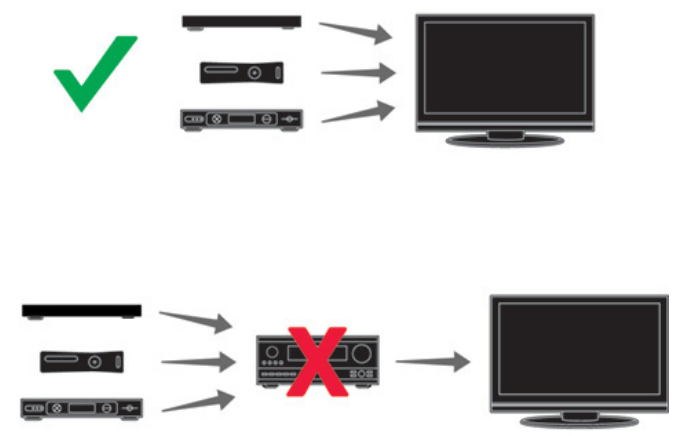
PLAYBAR Front
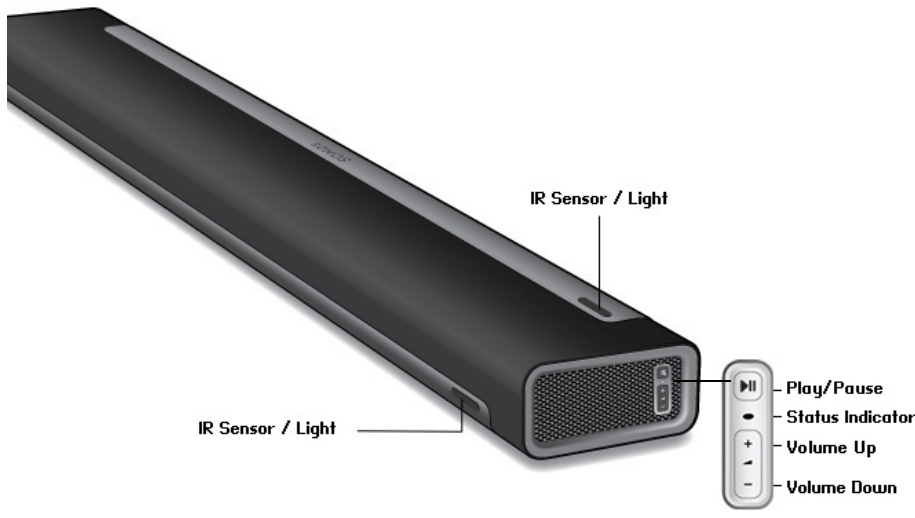
Note: The grill cloth is not removable. Tampering with the cloth may damage your PLAYBAR.
| Feature | Description |
|---|---|
| Play/Pause | - Toggles between playing and pausing the audio. |
| - When the TV is on, press once to mute the audio. | |
| - When the TV is off, press once to restart the previous music source, or press twice to skip to the next track (if applicable). | |
| Status Indicator Light | - Indicates the status of the PLAYBAR. |
| - LED is white during normal operation. This can be adjusted to disable the white light. | |
| - Refer to "White status light" on page 15 for details, or visit http://faq.sonos.com/led for a full list of status indications. | |
| Volume Up (+) / Volume Down (-) | - Press these buttons to adjust the volume up or down. |
| IR (InfraRed) Sensors / Signal Lights | - Receives signals from a remote control. |
| - When receiving a volume or mute command, the IR signal light flashes briefly. | |
| - You can adjust this setting so the light never appears (refer to page 14 for more info on "IR signal light"). |
PLAYBAR Back
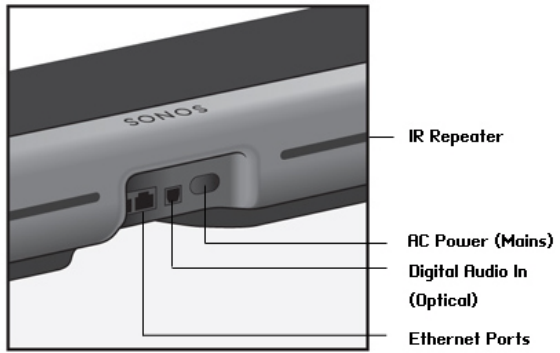
| Ethernet Ports (2) | You can use an Ethernet cable to connect the PLAYBAR to your home network. |
|---|---|
| Digital Audio In (Optical) | Use an audio optical cable (supplied) to connect the Sonos PLAYBAR’s digital audio input to the optical digital output on your television. Take care not to bend or twist the cable. 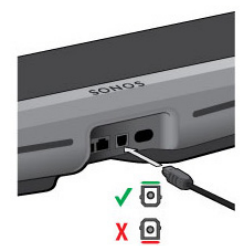 |
| The PLAYBAR's digital audio in and the optical cable end are 'D-shaped' — be sure to align for proper insertion. | |
| AC Power (Mains) Input | Use only the supplied power cord to connect to a power outlet (using a third-party power cord will void your warranty). Be sure to use the proper power adapter for your country. 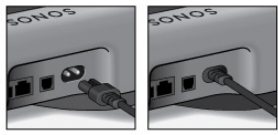 |
| Push the power cord firmly into the PLAYBAR until it is flush with the surface. | |
| IR Repeater | Allows the commands from your remote control to reach your TV if the PLAYBAR is positioned in front of the TV. This setting is on by default but can be turned off. |
| See "IR repeater" |
Selecting a Location
The PLAYBAR’s flexible design allows for multiple orientations. You can wall mount it above or below your television or place it on a tabletop. See the guidelines below for more information.
Tabletop
- Lay the PLAYBAR horizontally and flat on its feet.
- Do not place vertically or upright on its side.
- To preserve audio quality, ensure the connector panel faces toward the TV—Sonos logo should be closer to your TV.
- There is no placement restriction between the TV and PLAYBAR as long as the television’s IR is not blocked. The PLAYBAR IR repeater is designed for at least 2" (50mm) distance, but may work at a closer distance.
- Do not place the PLAYBAR in a cabinet or on a walled shelf. Both ends of the PLAYBAR should be at least 1 ft. (30cm) from a wall or other obstruction.
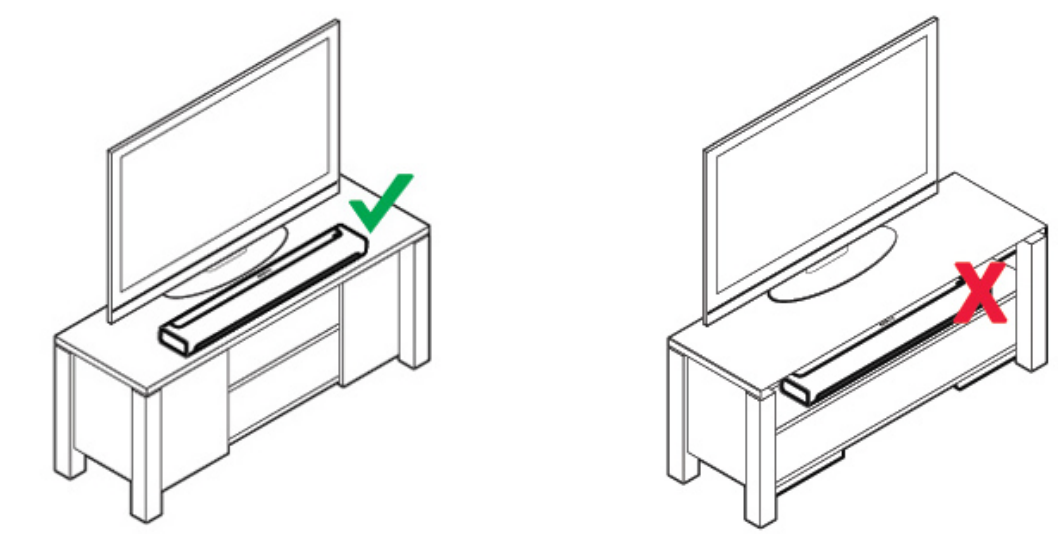
Wall mounting
The PLAYBAR can be mounted above or below your television using the PLAYBAR Wall Mount Kit (purchased separately). Please turn to page 22 for detailed wall-mounting instructions.
Setting Up the PLAYBAR
The PLAYBAR is compatible with Sonos software versions 4.0 and later. If you are adding the PLAYBAR to an existing Sonos system, be sure to check for software updates before adding the PLAYBAR to your Sonos system.
- Carefully unpack the package contents.
- Choose a location for the PLAYBAR. Refer to "Selecting a Location" on page 6 for help with this step.
- Remove the protective cap from each end of the optical audio cable.
Connect the optical audio cable (supplied) from your TV’s digital audio out (optical) to the PLAYBAR’s digital audio in (optical) being careful not to twist or bend the cable. The PLAYBAR’s digital audio in and the optical cable are ’D-shaped’—be sure to align for proper insertion.
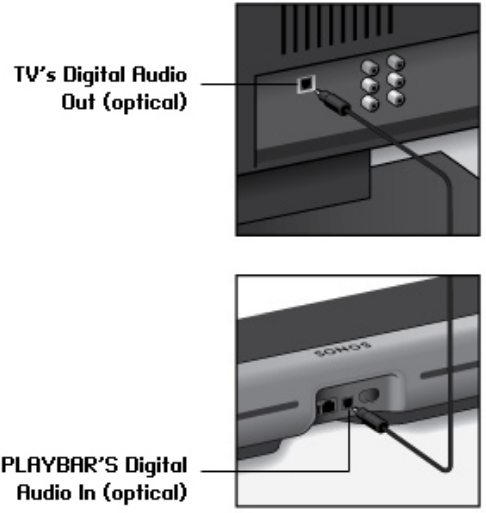
Attach the power adapter to the PLAYBAR and apply power. Be sure to push the power cord firmly into the PLAYBAR until it is flush with the surface.
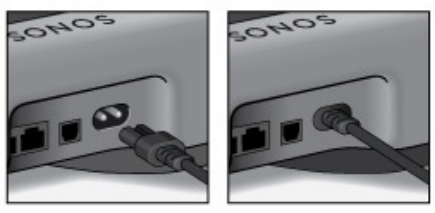
The status indicator light on the right side of the unit will begin to flash.
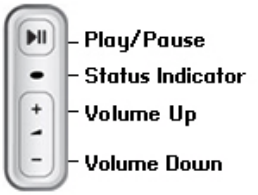
(OPTIONAL) If you are setting up your PLAYBAR with a SUB and/or surround speakers, position them in your room, apply power and connect a Sonos BRIDGE, BOOST or player to your router.
(You will be prompted to add these components to your Sonos system after the PLAYBAR is added.)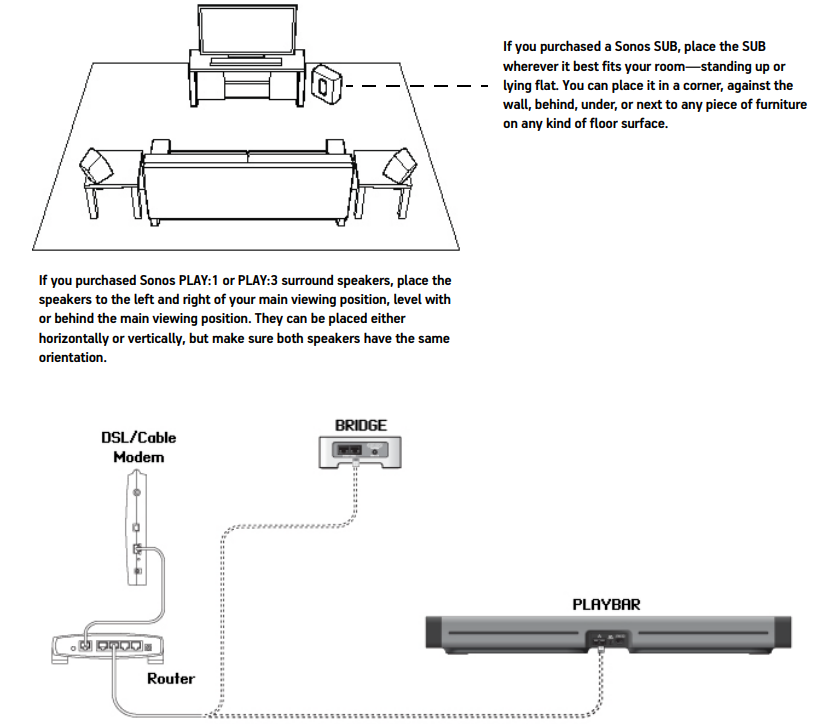
Note: Expandable PLAYBAR home theater setup
- For a 3.1 home theater experience, pair a SUB with your PLAYBAR.
- For a 5.1 home theater experience, pair a SUB and a pair of PLAY:1 or PLAY:3 speakers with your PLAYBAR.
If you are expanding your PLAYBAR home theater setup, be sure you have a BRIDGE, BOOST or Sonos player wired directly to your router.
Using a handheld Sonos controller (including Sonos CONTROL, iPad, iPhone, iPod touch, Android smartphone or tablet, Kindle Fire™), open the app and follow the online prompts to set up your Sonos system.
If you don’t have a Sonos controller app installed, download it from the application store on your device.
Note: Sonos does not recommend using the Sonos Controller for Mac or PC to set up your PLAYBAR.
If you are setting up a new Sonos system, when prompted, add your Sonos products in the following order:- Add the Sonos product that’s connected to your router.
- Add the PLAYBAR (if it is not the product connected to your router.)
- Add any additional Sonos products you purchased.
If you are adding to an existing Sonos system:
- First check for software updates—the PLAYBAR is compatible with Sonos software versions 4.0 and later.
- Add the PLAYBAR to your Sonos system by selecting Add a Player or SUB from the Settings menu on a handheld controller.
- Add any additional Sonos products you purchased.
You may be prompted to update the new Sonos product(s) after you add them to your Sonos system.
Thick walls, 2.4 GHz cordless telephones, or the presence of other wireless devices can interfere with or block the wireless network signals from your Sonos system. If you experience difficulty after positioning a Sonos product, try one or more of the following resolutions—relocate the Sonos product; change the wireless channel your music system is operating on; connect a Sonos product to your router if your setup is currently wireless.
If you’d like additional assistance:- If you need help turning off your TV speakers, see page 27 for more information.
- If you need help configuring a remote control to work with your PLAYBAR, see page 10 for more information.
- If a message appears on the TV whenever you adjust the volume up and down, it may be possible to eliminate it. If you are using a cable remote, see page 26. If you are using a universal remote, see page 27 for additional help.
- If you want to play music through the PLAYBAR, see page 20 for more information.
Description
The Sonos Playbar is a 2.1 channel soundbar that delivers high-fidelity sound for your TV and home entertainment system. It features nine built-in speakers, including six mid-range drivers and three tweeters, that provide crisp, clear audio with deep, rich bass. The Playbar supports a wide range of audio formats, including Dolby Digital 5.1 and PCM stereo, and can be easily expanded with additional Sonos speakers for a complete home theater setup. With its minimalist design and intuitive controls, the Sonos Playbar is the perfect combination of style and functionality.
PLAYBAR Settings
Follow the steps below if you wish to make changes to any PLAYBAR settings or the way the PLAYBAR works with your television.
- Remote Control Setup
- Equalization
- Recalibrating the Audio
- TV Dialog Settings
- Speech Enhancement
- Night Sound
- TV Autoplay
- IR Signal Light
- IR Repeater
- White Indicator Light
- Room Name
- Add SUB / Remove SUB (if SUB is present)
- Add / Remove Surround Speakers (if surround speakers are present)
Remote control setup
During PLAYBAR setup, you were guided through the process of configuring a remote control. If you did not configure one then, or wish to use a different remote control with your PLAYBAR, follow the steps below.
If you are configuring a new remote because a distracting message appears on the television whenever you adjust the volume, please go to "Eliminating annoying messages on your TV when using a cable, satellite, or set top box remote" on page 26, or "Eliminating annoying messages on your TV when using a universal remote" on page 27.
Using a handheld Sonos controller
- Select Room Settings from the Settings menu.
- Select the room your PLAYBAR is located in.
- Select TV Setup and Control -> Remote Control Setup.
If a remote control is already configured for use with your PLAYBAR you will be asked if you want to replace it. - Pick up the remote control you wish to begin using with the PLAYBAR.
- Point the remote at the PLAYBAR and press the Volume Up button on the remote control.
- If the remote control is recognized, click Done. You can now use that remote to control the volume and mute settings on your PLAYBAR.
- If the remote control is not recognized, you will be prompted to make additional button presses to complete the setup process.
Using the Sonos Controller for Mac or PC
- Select Manage -> Settings (PC) or Sonos -> Preferences (Mac).
- Select Room Settings if it is not already highlighted on the left.
- Choose the room the PLAYBAR is located in from the Room Settings for drop-down.
- Select the TV Setup tab.
- Click Remote Control Setup.
- Pick up the remote control you wish to begin using with the PLAYBAR, and then click Next.
- Point the remote at the PLAYBAR and press the Volume Up button on the remote control.
- If the remote control is recognized, click Done. You can now use that remote to control the volume and mute settings on your PLAYBAR.
- If the remote control is not recognized, you will be prompted to make additional button presses to complete the setup process.
If a message appears on the television whenever you adjust the volume up and down, please see "Eliminating annoying messages on your TV when using a cable, satellite, or set top box remote" on page 26 or "Eliminating annoying messages on your TV when using a universal remote" on page 27.
Equalization (EQ)
During the PLAYBAR setup process you were guided through the audio calibration process. If desired, you can change the sound settings (bass, treble or loudness) for the Sonos PLAYBAR. Bass boosts lower frequencies, treble boosts higher frequencies, while loudness boosts certain frequencies, including bass, to improve the sound at low volume.
Any manual EQ changes you make will be reset whenever you go through the audio recalibration process (see page 11 for more information).
Using a handheld Sonos controller
- From the Settings menu, select Room Settings.
- Select the room you want to adjust.
- Select Equalization.
- Choose one of the following options:
- Drag your finger across the bass or treble sliders to make adjustments.
- Select On or Off to adjust the Loudness setting.
Using the Sonos Controller for Mac or PC
- Select Manage -> Settings (PC) or Sonos -> Preferences (Mac).
- Select Room Settings if it is not already highlighted on the left.
- Choose the room the PLAYBAR is located in from the Room Settings for list, and then select the EQ tab.
- Choose one of the following options:
- Click and drag the bass or treble sliders to make adjustments.
- Click the Loudness checkbox to turn the loudness setting on or off.
- Close the Settings window when changes are complete.
Recalibrating the audio
If you have a SUB and/or Sonos surround speakers associated with your PLAYBAR, you may wish to make some adjustments after initial setup. You will likely wish to recalibrate the audio if you move any Sonos products in the room.
If you made any manual adjustments to EQ settings, these will be reset during the recalibration process.
Using a handheld Sonos controller
- From the Settings menu, select Room Settings.
- Select the room that is associated with the surround components. It appears as Room (+SUB) or Room (+LS+RS) or Room (+SUB+LS+RS) on the Room Settings menu.
- Select Advanced Audio -> Recalibrate Audio.
- Follow the prompts to optimize your audio performance.
- If you have a SUB associated with your PLAYBAR, you will be asked to choose between 2 test sounds:
- Press
 Play to compare the volume of two test sounds, A and B, and then select No Difference, A is louder or B is louder. If you don’t hear a noticeable difference, select No Difference.
Play to compare the volume of two test sounds, A and B, and then select No Difference, A is louder or B is louder. If you don’t hear a noticeable difference, select No Difference. - Press
 Play to listen to a test sound, and then select the level you prefer.
Play to listen to a test sound, and then select the level you prefer. - If you have surround speakers associated with your PLAYBAR, you will be asked to answer some room configuration questions.
- Press
Using the Sonos Controller for Mac or PC
- Select Manage -> Settings (PC) or Sonos -> Preferences (Mac).
- Select Room Settings.
- Select the room that is associated with the surround components. It appears as Room (+SUB) or Room (+LS+RS) or Room (+SUB+LS+RS) on the Room Settings menu.
- Select the Basic tab, and then select Recalibrate Audio.
- Follow the prompts to optimize your audio performance:
- If you have a SUB associated with your PLAYBAR, you will be asked to choose between 2 test sounds:
- Press
 Play to compare the volume of two test sounds, A and B, and then select No Difference, A is louder or B is louder. If you don’t hear a noticeable difference, select No Difference.
Play to compare the volume of two test sounds, A and B, and then select No Difference, A is louder or B is louder. If you don’t hear a noticeable difference, select No Difference. - Press
 Play to listen to a test sound, and then select the level you prefer.
Play to listen to a test sound, and then select the level you prefer. - If you have surround speakers associated with your PLAYBAR, you will be asked to answer some room configuration questions.
TV dialog settings
Using a handheld Sonos controller
- From the Settings menu, select Room Settings.
- Select the room the PLAYBAR is located in.
- Select Advanced Audio -> TV Dialog Settings.
- Audio Delay (Lip Sync). Drag your finger across the slider to increase or decrease the sound delay if the image and the sound are not in sync.
Using the Sonos Controller for Mac or PC
- Select Manage -> Settings (PC) or Sonos -> Preferences (Mac).
- Select Room Settings if it is not already highlighted on the left.
- Choose the room the PLAYBAR is located in from the Room Settings for drop-down.
- Select the TV Dialog tab.
- Click and drag the Audio Delay (Lip Sync) slider to increase or decrease the sound delay if the image and the audio are not in sync.
- Close the Settings window when changes are complete.
Additional TV sound options
![]() Speech Enhancement
Speech Enhancement
The Speech Enhancement setting makes the TV dialog easier to hear. Touch the icon on your Sonos controller’s Now Playing screen to turn this setting on or off. (If the setting isn’t visible, make sure the room with the PLAYBAR is selected.)
![]() Night Sound
Night Sound
The Night Sound setting adjusts the audio for night time viewing so you can reduce the volume and still experience proper balance and range. At lower volumes, quiet sounds are enhanced and the intensity of loud sounds is reduced. Touch the icon on your Sonos controller’s Now Playing screen to turn this setting on or off. (If the setting isn’t visible, make sure the room with the PLAYBAR is selected.)
TV autoplay
When TV Autoplay is set to On, TV audio automatically plays through the PLAYBAR when you turn on your television—if music is playing when the TV is turned on, the music immediately stops and the PLAYBAR switches to TV audio. Additionally, if the PLAYBAR is in a room group when the TV is turned on, it automatically drops from the group. This setting is On by default.
Using a handheld Sonos controller
- From the Settings menu, select Room Settings.
- Select the room the PLAYBAR is located in.
- Select TV Setup and Control -> TV Autoplay.
- Select On or Off.
Using the Sonos Controller for Mac or PC
- Select Manage -> Settings (PC) or Sonos -> Preferences (Mac).
- Select Room Settings if it is not already highlighted on the left.
- Choose the room the PLAYBAR is located in from the Room Settings for drop-down.
- Select the TV Setup tab.
- Check the TV Autoplay checkbox to turn this setting on, uncheck to turn it off.
- Close the Settings window when changes are complete.
Ungroup on autoplay
As with any Sonos player, you can group and ungroup the PLAYBAR with other rooms. If ungroup on autoplay is checked, any Sonos rooms that are grouped with the PLAYBAR when the TV is turned on will automatically drop from the group. This setting is Yes by default.
Using a handheld Sonos controller
- From the Settings menu, select Room Settings.
- Select the room the PLAYBAR is located in.
- Select TV Setup and Control -> Ungroup on Autoplay.
- Select Yes or No.
Using the Sonos Controller for Mac or PC
- Select Manage -> Settings (PC) or Sonos -> Preferences (Mac).
- Select Room Settings if it is not already highlighted on the left.
- Choose the room the PLAYBAR is located in from the Room Settings for drop-down.
- Select the TV Setup tab.
- Check the Ungroup on Autoplay checkbox to turn this setting on, uncheck to turn it off.
- Close the Settings window when changes are complete.
IR Signal Light
A light displays on the PLAYBAR when an IR signal is being sent. If desired, you can adjust this setting so the IR light never displays. This setting is On by default.
Using a Handheld Sonos Controller
- From the Settings menu, select Room Settings.
- Select the room the PLAYBAR is located in.
- Select TV Setup and Control -> IR Signal Light.
- Select On or Off.
Using the Sonos Controller for Mac or PC
- Select Manage -> Settings (PC) or Sonos -> Preferences (Mac).
- Select Room Settings if it is not already highlighted on the left.
- Choose the room the PLAYBAR is located in from the Room Settings for drop-down.
- Select the TV Setup tab.
- Check the IR Signal Light checkbox to turn this setting on, uncheck to turn it off.
- Close the Settings window when changes are complete.
IR Repeater
When the PLAYBAR is placed in front of your TV on a tabletop, it may block the IR sensor on your TV. The IR repeater setting allows the PLAYBAR to repeat the signal to your TV. This setting is On by default.
Using a Handheld Sonos Controller
- From the Settings menu, select Room Settings.
- Select the room the PLAYBAR is located in.
- Select TV Setup and Control -> IR Repeater.
- Select On or Off.
Using the Sonos Controller for Mac or PC
- Select Manage -> Settings (PC) or Sonos -> Preferences (Mac).
- Select Room Settings if it is not already highlighted on the left.
- Choose the room the PLAYBAR is located in from the Room Settings for drop-down.
- Select the TV Setup tab.
- Check the IR Repeater checkbox to turn this setting on, uncheck to turn it off.
- Close the Settings window when changes are complete.
White Status Light
A white light displays on the side of the PLAYBAR to indicate that the unit is functioning in normal operation. If desired, you can turn this indicator light off so that when the PLAYBAR is in normal operation the white light does not display. This setting is On by default.
If the Status indicator light begins to flash orange, go to http://faq.sonos.com/led for additional information.
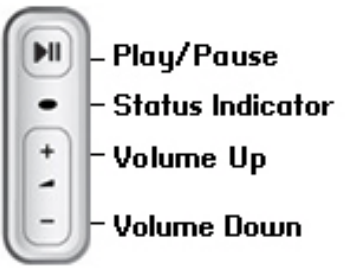
Using a Handheld Sonos Controller
- From the Settings menu, select Room Settings.
- Select the room you want to change.
- Select White Status Light.
- Select On or Off.
Using the Sonos Controller for Mac or PC
- Select Manage -> Settings (PC) or Sonos -> Preferences (Mac).
- Select Room Settings if it is not already highlighted on the left.
- Choose the room you want to change from the Room Settings for drop-down.
- From the Basic tab, click the White Status Light On checkbox to turn the light on or uncheck to turn it off.
Changing Room Names
Using a Handheld Sonos Controller
- From the Settings menu, select Room Settings.
- Select the room you wish to change.
- Select Room Name.
- Select a new name from the list and touch OK, or select Enter New to type a unique name.
Using the Sonos Controller for Mac or PC
- Select Manage -> Settings (PC) or Sonos -> Preferences (Mac).
- Select Room Settings if it is not already highlighted on the left.
- Choose the room you wish to change from the Room Settings for drop-down list.
- Choose a new name from the Room Name list.
Sonos Playbar Hi-Fi Sound SUB
Adding a Sonos SUB
You can pair a SUB with the PLAYBAR to add to your cinematic experience.
Using a Handheld Sonos Controller
- From the Settings menu, select Room Settings.
- Select the room the PLAYBAR is located in.
- Select Add SUB.
- Follow the prompts to add the SUB to your Sonos system.
Using the Sonos Controller for Mac or PC
- Select Manage -> Settings (PC) or Sonos -> Preferences (Mac).
- Select Room Settings if it is not already highlighted on the left.
- From the Basic tab, select Add SUB.
- Follow the prompts to add the SUB to your Sonos system.
SUB Settings
Follow the steps below if you wish to make any changes to the SUB settings.
Using a Handheld Sonos Controller
- From the Settings menu, select Room Settings.
- Select the room the PLAYBAR and SUB are located in. It appears as Room (+SUB) on the Room Settings menu.
- Select Advanced Audio -> SUB Settings.
- Choose one of the following:
- SUB: Choose On or Off to turn the sound from the SUB on and off.
- SUB Level Adjustment: Drag your finger across the slider to increase or decrease the volume of the SUB. (You can use this setting to match the subwoofer level to the level of your main speakers.)
- Placement Adjustment (phase): Select On or Off.
Using the Sonos Controller for Mac or PC
- Select Manage -> Settings (PC) or Sonos -> Preferences (Mac).
- Select Room Settings if it is not already highlighted on the left.
- Choose the room the PLAYBAR and SUB are located in from the Room Settings for drop-down. It appears as Room (+SUB).
- Select the SUB tab.
- Choose one of the following:
- SUB: Check to turn the sound from the SUB on; uncheck to turn it off.
- SUB Level Adjustment: Click and drag the slider to increase or decrease the volume of the SUB. (You can use this setting to match the subwoofer level to the level of your main speakers.)
- Placement Adjustment (phase): Check to turn on; uncheck to turn it off.
Removing a SUB
Using a Handheld Sonos Controller
- From the Settings menu, select Room Settings.
- Select the room the SUB is associated with. It appears as Room (+SUB) on the Room Settings menu.
- Select Remove SUB.
- Choose one of the following settings:
- If you want to associate the SUB with a different Sonos player, select Choose Room for SUB and then select another room.
- If you are not going to use the SUB right now, select Don’t use SUB. It will appear on the Rooms menu as SUB (unused) until you select it and associate it with another Sonos player.
Using the Sonos Controller for Mac or PC
- Select Manage -> Settings (PC) or Sonos -> Preferences (Mac).
- Select Room Settings if it is not already highlighted on the left.
- Choose the room the PLAYBAR is located in from the Room Settings for drop-down list.
- From the Basic tab, click Remove SUB.
Surround Speakers
Adding Surround Speakers
You can easily pair two PLAY:1 or PLAY:3 products with a PLAYBAR to function as left and right surround channels in your Sonos surround sound experience. You can either configure surround speakers during the setup process or follow the steps below to add them later.
- Make sure the Sonos players are the same—you cannot combine a PLAY:1 and a PLAY:3 to function as surround speakers.
- Pairing surround speakers with your PLAYBAR requires a wired connection, so ensure you have a BRIDGE, BOOST, or Sonos player connected to your router with an Ethernet cable before proceeding.
- Be sure to follow the instructions below to set up your surround speakers. Do not create a room group or stereo pair as these will not achieve the left and right surround channel functionality.
Using a Handheld Sonos Controller
- From the Settings menu, select Room Settings.
- Select the room the PLAYBAR is located in.
- Select Add Surround Speakers.
- Follow the prompts to add first a left and then a right surround speaker.
Using the Sonos Controller for Mac or PC
- Select Manage -> Settings (PC) or Sonos -> Preferences (Mac).
- Select Room Settings if it is not already highlighted on the left.
- From the Basic tab, select Add Surround Speakers.
- Follow the prompts to add first a left and then a right surround speaker.
Surround Settings
The default setting is determined by the calibration process. If you wish to make a change, you can follow the steps below.
Using a Handheld Sonos Controller
- From the Settings menu, select Room Settings.
- Select the room the PLAYBAR and surround speakers are located in. It appears as Room (+LS+RS) on the Room Settings menu.
- Select Advanced Audio -> Surround Settings.
- Choose one of the following:
- Surrounds: Choose On or Off to turn the sound from the surround speakers on and off.
- Surround Level Adjustment: Drag your finger across the slider to increase or decrease the volume of the surround speakers.
- Music Playback: Choose Ambient (default; subtle, ambient sound) or Full (enables louder, full-range sound). This setting applies only to music playback, not TV audio.
Using the Sonos Controller for Mac or PC
- Select Manage -> Settings (PC) or Sonos -> Preferences (Mac).
- Select Room Settings if it is not already highlighted on the left.
- Choose the room the PLAYBAR and surround speakers are located in from the Room Settings for drop-down.
- Select the Surrounds tab.
- Choose one of the following:
- Surrounds: Check to turn the sound from the surround speakers on; uncheck to turn it off.
- Surround Level Adjustment: Click and drag the slider to increase or decrease the volume of the surround speakers.
- Music Playback: Choose Ambient (default; subtle, ambient sound) or Full (enables louder, full-range sound). This setting applies only to music playback, not TV audio.
- Close the Settings window when changes are complete.
Removing Surround Speakers
Using a Handheld Sonos Controller
- From the Settings menu, select Room Settings.
- Select the room the surround speakers are associated with. The room name appears as Room (+LS+RS) on the Room Settings menu.
- Select Remove Surround Speakers.
- Select Next to drop the surround sound speakers from your surround system.
- If these were newly purchased players, they will appear as Unused on the Rooms menu.
- If the players existed in your household previously, they revert back to their previous state.
You can now move them to another room for individual use. If you want to add them back as surround speakers, see Adding Surround Speakers on page 18 for help.
Using the Sonos Controller for Mac or PC
- Select Manage -> Settings (PC) or Sonos -> Preferences (Mac).
- Select Room Settings if it is not already highlighted on the left.
- Choose the room the PLAYBAR is located in from the Room Settings for drop-down list. The room name appears as Room (+LS+RS).
- From the Basic tab, click Remove Surround Speakers.
- If these were newly purchased players, they will appear as Unused in the Rooms pane.
- If the players existed in your household previously, they revert back to their previous state.
Playing Music
The PLAYBAR doubles as an all-in-one Sonos player that allows you to stream all the music on earth. You can use any Sonos controller to select music—simply touch![]() to select from the music menu on a handheld controller, or click to select from the MUSIC pane within the Sonos Controller for Mac or PC.
to select from the music menu on a handheld controller, or click to select from the MUSIC pane within the Sonos Controller for Mac or PC.
Radio Note:
If TV Autoplay is set to On, the PLAYBAR automatically stops playing music and switches to TV audio whenever the TV is turned on.
Radio
Sonos includes a radio guide that provides immediate access to thousands of free internet radio stations and broadcast programs. You can easily find radio stations from all over the world—music, news, and variety programming, including archived shows and podcasts.
To select a radio station, simply select Radio and choose a station.
Music Services
A music service is an online music store or online service that sells audio on a per-song, per audiobook, or subscription basis. Sonos is compatible with several music services—you can visit the website at www.sonos.com/howitworks/music/partners for the latest list. (Some music services may not be available in your country. Please check the individual music service’s website for more information.)
If you are currently subscribed to a music service that’s compatible with Sonos, simply add your music service username and password information to Sonos as needed, and you’ll have instant access to the music service from your Sonos system.
To add a music service:
- Touch Add Music Services from the Sonos music menu on your handheld controller.
- Select the Sonos-compatible music service you would like to add.
- Select Add Account, and then follow the on-screen prompts. Your login and password will be verified with the music service. As soon as your credentials have been verified, the music service displays on the Sonos music menu.
Free music service trials are available in some countries. (Please check the individual music service’s website for more information.) If there is a music service trial visible on the Music Services menu, simply touch it to select. Touch Add Account -> I’m new to [music service], and then follow the prompts to activate the music trial. After the trial period is up, you will need to subscribe to the music service to keep the music playing.
Local Music Library
The Sonos system can play music from any computer or network-attached storage (NAS) device on your home network where you have shared music folders. During the setup process, you are guided through the process of accessing your local music library (such as your iTunes library). Over time, you may wish to add or remove folders from this list.
To make changes to your local music library:
- Select the Settings menu from a handheld Sonos controller.
- Choose one of the following options:
- To add a new music folder, select Manage Music Library -> Music Library Setup -> Add New Share.
- To remove a music folder, select Manage Music Library -> Music Library Setup. Touch the share you wish to remove and then select Remove.
The Sonos system indexes your local music so you can view your music collection by categories (such as artists, albums, composers, genres, or tracks). If you add new music, simply update your music index to add this music to your Sonos music library.
To update your music library:
- Select Manage Music Library -> Update Music Index Now.
- If you’d like your music library to update automatically each day, select Schedule Music Index Updates and then select an update time.
Wireless iTunes Playback
You can select and play music and podcasts stored on any iPad, iPhone, or iPod touch that’s on the same network as your Sonos products. Playback is perfectly synchronized, in any or every room of your home. Simply choose This iPad, This iPhone, or This iPod touch from the Sonos app on your iOS device to make audio selections, and then you can use any Sonos controller to control playback.
Note:
Wireless playback requires Sonos Controller App for iPhone or iPad version 3.8.3 or higher and devices running iOS software version 6.0 or later.
Wireless Playback from Android Devices
You can select and play music stored on any Android device that’s on the same network as your Sonos products. Playback is perfectly synchronized, in any or every room of your home. Simply choose This Mobile Device from the Sonos app on your Android smartphone or tablet to make audio selections, and then you can use any Sonos controller to control playback.
Note:
Wireless music playback is compatible with Sonos software update 4.1.1 and higher, and any device running Android 2.1 and higher. (Wireless playback of podcasts is supported on Android 2.2 and higher.)
Google Play Music (Android Devices)
You can play music to your Sonos system directly from the Google Play Music app on any Android device. This feature is available for both Standard and All Access Google Play Music customers.
To play music directly from the Google Play Music app to your Sonos system:
- You must have both the Google Play Music app and the Sonos Controller App installed on your mobile device.
- Sonos playback from Google Play Music is compatible with Sonos software update 4.3 and higher, and with any device running Android 2.3 and higher.
Simply open the Google Play Music app and connect to a Sonos room or room group to start the music. When you are finished, disconnect the Sonos room from the app.
Wall Mounting
The PLAYBAR can be wall mounted above or below your wall-mounted television using the PLAYBAR Wall Mount Kit. To preserve audio quality, ensure the connector panel faces away from the TV when mounted—the Sonos logo should be farther from your TV.
Note:
It is recommended that you connect the power and audio cables to the PLAYBAR before mounting on the wall.
What You Will Need
- PLAYBAR Wall Mount Kit (sold separately)
- Masking tape
- An awl or other pointed tool
- A Phillips head screwdriver
- Power drill with Phillips head attachment
Wall Mounting Instructions
Positioning the Template
Hold the PLAYBAR wall mount template (included in the wall mount kit) in the desired position on your wall. The PLAYBAR can be mounted either above or below your television.
IMPORTANT: For optimal audio performance, Sonos recommends:
- When mounting below a television, allow 1 inch (25mm) clearance between the PLAYBAR and the TV.
- When mounting above a television, allow 2 inches (50mm) clearance between the PLAYBAR and the TV.
- Leveling the Template
- Use a level (included in the wall mount kit) to ensure the template is horizontally level, and then tape the template securely to the wall.
- Marking the Drill Holes
Use an awl or other sharp object to punch 4 small holes through 4 of the marked locations on the template. (If additional reinforcement is desired, 2 spare screws and anchors are included in the wall mount kit.) Placement may vary but holes should be located toward the corners, away from the center.
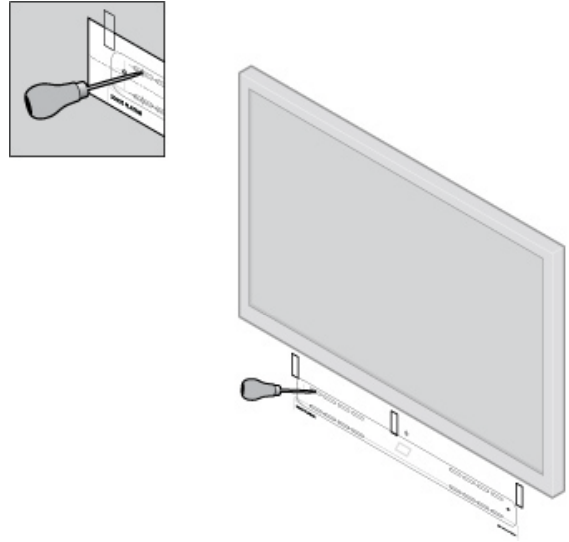
- Removing the Template
- Remove the template from the wall.
- Drilling Pilot Holes
Drill pilot holes.
While the anchors and screws are designed to be self-starting, this step is optional. However, pre-drilling will result in a more accurate installation. Refer to the table below for more information.Wall Material Pre Drill Use Wall Anchors Use Screws Wood Stud with 1/8" (3mm) bit No Yes Drywall (no stud) with 3/16" (4.5mm) bit Yes Yes Hard wallboard or double board with 3/16" (4.5mm) bit Yes Yes Plaster with 1/4" (6.5mm) bit Yes Yes Concrete or Brick with 1/8" (3mm) bit Yes Yes
- Securing the Wall Anchors
Insert and secure the wall anchors (supplied in the wall mount kit).
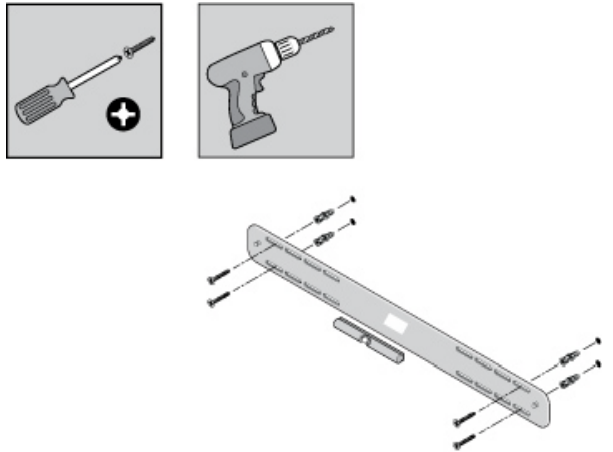
- If drilling into wood stud: Do not use the wall anchors.
- If drilling into Sheetrock: Screw the wall anchors into the drywall with a Phillips head screwdriver until the head is flat against or slightly below the wall surface, being careful not to overtighten.
Note:
The anchors can be installed using a screw gun or a regular power drill with a Phillips head screwdriver attachment. If drilling into Sheetrock, the surface of the drywall may distort slightly or dimple as the anchor is installed. This is not unusual.
- Fastening the PLAYBAR Bracket
Fasten the PLAYBAR bracket to the wall using the screws supplied in the wall mount kit. Use the level to verify accuracy a final time, and then tighten the screws securely
Note: Hanging the PLAYBAR Hang the PLAYBAR securely on the two (2) bracket pegs.
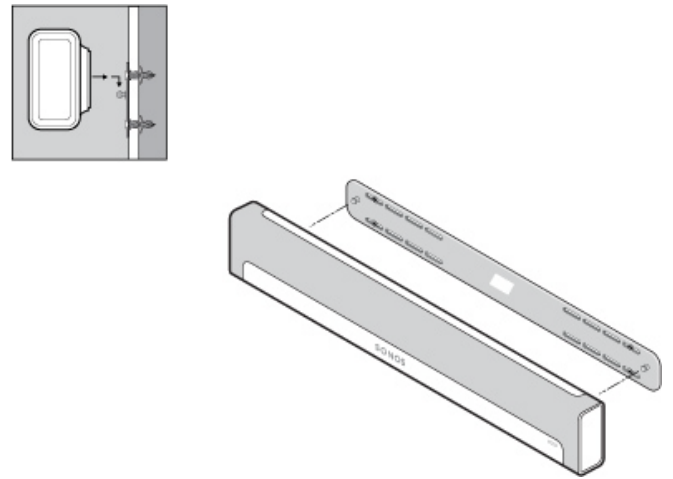
Indicator Light Explanations
| Indicator Lights | Player State | Sonos Product | Additional Information |
|---|---|---|---|
| Solid white | Powered up and associated with a Sonos system | BRIDGE, BOOST, CONNECT™, SUB, CONNECT, DOCK, PLAY:1, PLAY:3, PLAY:5, PLAYBAR | If desired, when the product is in normal operation, you can turn the white status indicator light on or off by selecting White Status Light from the Room Settings menu. (The SUB indicator will reflect the same setting as the player it is paired with.) |
| Flashing white | Powering up | BRIDGE, BOOST, CONNECT, SUB, CONNECT, DOCK, PLAY:1, PLAY:3, PLAY:5, PLAYBAR | |
| Flashing green | Powered up, not yet associated with a Sonos system | BRIDGE, BOOST, CONNECT, SUB, CONNECT, DOCK, PLAY:1, PLAY:3, PLAY:5, PLAYBAR | For a SUB, this may indicate the SUB is not yet paired with a player. |
| Solid green | Volume set to zero or muted | CONNECT, CONNECT, PLAY:1, PLAY:3, PLAY:5, PLAYBAR | |
| Slowly flashing green | Surround audio is off or SUB audio is off | PLAY:1, PLAY:3, SUB | Applicable for a player configured as a PLAYBAR surround speaker, or for a SUB paired with a PLAYBAR |
| Solid orange | During wireless setup, this occurs while the Sonos open access point is temporarily active. If you are not setting up your Sonos system, this may indicate warning mode. | CONNECT, SUB, CONNECT, PLAY:1, PLAY:3, PLAY:5, PLAYBAR | If the orange light is on AND the player’s volume level automatically reduces, this indicates the player is in warning mode. - Press the Pause button to stop the audio. - Check the vent slot for adequate cooling. - Check the room temperature to make sure it’s less than 104°F / 40°C. - Provide shade if needed. - Allow the player to cool for several minutes, then press Play to restart. - If the problem persists, contact Customer Support. |
| Rapidly flashing orange | Playback / Next Track failed | CONNECT, CONNECT, PLAY:1, PLAY:3, PLAY:5, PLAYBAR | Indicates either playback or next track was not possible |
| Flashing orange | During SonosNet setup, this occurs after a button press while the product is searching for a household to join. | BRIDGE, BOOST, CONNECT, SUB, CONNECT, DOCK, PLAY:1, PLAY:3, PLAY:5, PLAYBAR | |
| Slowly flashing orange and white | Fault mode | CONNECT, CONNECT, PLAY:1, PLAY:3, PLAY:5, PLAYBAR, SUB | If the lights are flashing orange and white AND the volume automatically mutes, this indicates the player is experiencing a fault condition. - Press the Pause button to stop the audio. - Check the room temperature to make sure it’s less than 104°F / 40°C. - Provide shade if needed. - Allow the player to cool for several minutes, then press Play to restart. - If the problem persists, contact Customer Support. |
Setup Guide
Setting up the Sonos Playbar is a breeze.
- Simply connect the Playbar to your TV using the included optical cable, plug it in, and download the Sonos app on your smartphone or tablet.
- From there, the app will guide you through the setup process, allowing you to connect to your Wi-Fi network and start streaming your favorite music and movies.
- The Playbar can also be paired with other Sonos speakers for a seamless, multi-room audio experience.
Important Safety Information
Please read these instructions and heed all warnings. Keep them in a convenient location and make sure everyone in the household is aware of them.
Location
- Do not place the unit where it will be exposed to excessive heat (e.g., radiators, heat registers, stoves), direct sunlight, or a dusty environment (e.g., woodworking shop.)
- Do not place the unit where it will be exposed to flammable liquids and/or fumes.
- Do not place the unit in a small confined space (e.g., closet or cabinet, under a bed or sofa) where ventilation is restricted. Both ends of the PLAYBAR should be at least 1 ft. (30cm) from a wall or other obstruction.
- Protect the power cable from being walked on or pinched, particularly at plugs, convenience receptacles, and the point where it exits the product. The mains cord should be readily available to disconnect the power.
- The product should not be used near water—avoid close proximity to a bathtub, kitchen sink, laundry tub, wet basement, swimming pool, etc.
- If the unit is being wall-mounted, use the PLAYBAR Wall Mount Kit (purchased separately) and follow the instructions carefully. Improper or inadequate installation could cause your device to fall, resulting in personal injury.
Proper Ventilation
- Leave one inch of open space around the sides and above the unit to ensure proper ventilation.
- Ventilation should not be impeded by covering the ventilation openings with items such as tablecloths, curtains, or papers.
- Do not let foreign objects into the unit. If a foreign object should get into the unit, unplug the unit and contact Sonos for servicing guidance.
Usage
- Do not operate or handle the product with wet hands.
- Do not place any object on top of the product (e.g. vase, coffee cup, potted plant, books, magazines, etc.)
- Only use attachment/accessories specified by Sonos.
- Unplug the power cord during lightning storms or when unused for long periods of time.
- Never disassemble or modify the product in any way.
- If the PLAYBAR is wall-mounted, never hang from the PLAYBAR or the wall mount bracket.
- If the PLAYBAR is wall-mounted, perform safety checks on a regular basis to ensure screws remain tightened securely
Cleaning & Maintenance
- Keep the PLAYBAR fabric free from dust, pet hair, and other fine particles.
- To clean the fabric, use a vacuum with a hose or non-moving bristle attachment. Do not vacuum with a rotating bristle attachment.
- A lint brush can be used to smooth out visible lines in the fabric. Do not clean fabric with a lint roller.
- Clean non-fabric portions of the PLAYBAR only with a dry, soft cloth. Household cleaners or solvents may damage the finish on your Sonos products.
- Do not use chemical solvents (e.g. alcohol, benzene, paint thinner) or other flammable cleaning liquids
- Refer all servicing to Sonos qualified service personnel. Servicing is required when the unit or the power cord has been damaged in any way, if liquid or other foreign matter has fallen into the ventilation openings, or the unit has been exposed to rain or moisture.Warning: To reduce the risk of fire or electric shock, do not expose this apparatus to rain or moisture.
Basic Troubleshooting of Sonos Playbar Hi-Fi Sound
Warning:
Do not open the product as there is a risk of electric shock. Under no circumstances should the product be repaired by anyone other than an authorized Sonos repair center, as this will invalidate the warranty. Please contact Sonos Customer Support for more information.
- The grill cloth is not removable. Tampering with the cloth may damage your PLAYBAR.
- If a problem occurs, you can try the troubleshooting suggestions listed below. If one of these doesn’t remedy the problem, or you are not sure how to proceed, please contact the Sonos Customer Support team, and we’ll be happy to help.
PLAYBAR Not Detected During Setup
- Did you allow Sonos to check for updates?
The Sonos PLAYBAR requires software version 4.0 or later. - Is the power cord properly seated?
Be sure to push the power cord firmly into the PLAYBAR until it is flush with the surface. - Network Issues:
If either of these is not the problem, a network issue may be preventing the PLAYBAR from connecting to your Sonos system. Try moving the Sonos products closer together.
Eliminating Annoying Messages on Your TV When Using a Cable, Satellite, or Set-Top Box Remote
After you disable your TV speakers, your television might display an annoying or confusing message when you adjust the volume on the PLAYBAR. This could be a message reminding you that your TV speakers are off, or a volume indicator unrelated to the sound from your PLAYBAR. If you have a programmable remote control, you can try the steps below. These steps will configure your remote control to send volume commands that are only recognized by the PLAYBAR so the message no longer appears when you increase or decrease the volume.
- Identify an Unused Device Key:
Your remote control can likely control a variety of devices. The device keys are usually located at the top of the remote and labeled TV/Cable/CBL/STB/DVD/AUX. Identify a device key that is not currently being used (for example, the AUX key). - Program the Unused Device Key:
Programming the unused device key will add new volume commands to your remote control. Refer to the printed instructions that came with your remote control or browse the on-screen help menu on your cable/satellite/set-top box as specific details will vary by manufacturer.- From the list of codes that can be programmed, select a Sonos code if it appears in the list.
- If Sonos does not appear, select a code for any manufacturer brand other than your TV or other devices connected to the TV.
- DO NOT initiate an automated search for a code.
- Lock Your Remote Control to the New Volume Commands:
Locking volume control to the new device will ensure your remote always sends the new volume commands. This feature is likely referred to as volume lock or volume punch-through in the instructions that accompanied your remote control. - Configure Your PLAYBAR to Work with the New Volume Commands:
See "Remote control setup" on page 10 for help with this step. - Verify That the Problem Is Solved:
If the problem persists, try repeating the steps above, choosing a different manufacturer brand when programming the unused device key.
Eliminating Annoying Messages on Your TV When Using a Universal Remote
After you disable your TV speakers, your television might display an annoying or confusing message whenever you adjust the volume on the PLAYBAR. This could be a message reminding you that your TV speakers are off, or a volume indicator unrelated to the sound from your PLAYBAR. Try the steps below to configure your universal remote so this message no longer appears when you increase or decrease the PLAYBAR’s volume.
Sonos recommends you purchase a Logitech Harmony universal remote.
If You Are Using a Logitech Universal Remote
- Use the USB cable provided by Logitech to connect your Harmony remote to your computer.
Note: If this remote is a new purchase, you will need to set up a Logitech user account and install the Harmony Remote software before proceeding. - Launch the Logitech Harmony Remote software or go to www.logitech.com/myharmony and login to your account.
(Where you are directed depends on the Logitech universal remote model you purchased.) - Select the Add Device setting.
- Choose one of the following options:
- Logitech Harmony Remote Software:
Select Sonos as the manufacturer, and enter PLAYBAR as the model name/number. If the Sonos PLAYBAR is not in their database, you will be asked to add it. Confirm your entry and save your changes. - My Harmony Website:
Type Sonos as the manufacturer and PLAYBAR as the model name. If the Sonos PLAYBAR is not in their database, you will be asked to confirm your entry or make another choice. Confirm and save your changes.
- Logitech Harmony Remote Software:
If You Are Using Another Universal Remote
Follow the instruction, “Eliminating Annoying Messages on Your TV When Using a Cable, Satellite, or Set-Top Box Remote.”
Turning Off Your Television’s Speakers
During the setup process, you are prompted to turn off your TV speakers so the sound comes only through the PLAYBAR. While Sonos cannot provide instructions for every television model, please try the steps below. If you cannot find the correct setting to turn off your TV speakers, consult the owner's guide that was packaged with your television.
- Select the Menu or Setup button on your television’s remote control (not your cable remote control). An on-screen menu will appear.
- Select the menu option that controls your television’s audio functions.
Note: This menu selection is most often labeled Audio, Sound, Tools, or Options, or may display as a musical note icon. - Select the appropriate setting to turn off your TV speakers. Depending on your TV make and model, choices may include:
- Off / On
- External Speaker / Television Speaker
- Audio System / Television Speaker
(The choice in bold will turn the TV speakers off.)
- If none of these are applicable to your television, look for a setting that switches your TV output between variable and fixed and try switching the setting.
Can’t Turn Off TV Speakers?
Some brands, including Toshiba and Dynex, may not include this setting. If you are unable to turn off the TV speakers, follow the steps below:
- Using the volume control buttons on your television, turn the TV volume all the way down. Do not use the Mute button.
- From this point forward, use only the volume buttons on your Sonos controller to adjust the PLAYBAR’s volume.
Pros & Cons
Pros
- High-fidelity sound with deep, rich bass
- Sleek and minimalist design
- Easy setup and intuitive controls
- Support for a wide range of audio formats
- Can be expanded with additional Sonos speakers
Cons
- Expensive for a soundbar
- No Bluetooth connectivity
- Requires a Wi-Fi connection for setup and streaming
- Limited input options
Customer Reviews
Customers rave about the Sonos Playbar's high-fidelity sound and easy setup. Many note that the Playbar provides a significant improvement in sound quality over their TV's built-in speakers. However, some customers have reported issues with connectivity and setup, and a few have noted that the Playbar is more expensive than other soundbars in its class. Despite these minor drawbacks, the Sonos Playbar remains a popular choice for those seeking a premium audio experience for their home entertainment system.
Faqs
How should my Sonos Playbar Hi-Fi Sound System be configured?
How can I use the Sonos Playbar to fix sound delays?
Do I need a subwoofer to utilize the Sonos Playbar?
How can I fix it when my Sonos Playbar won't connect to the WiFi?
Is Google Assistant or Alexa compatible with the Sonos Playbar?
How can I go back to the factory settings on my Sonos Playbar?
Is it possible to wall-mount the Sonos Playbar?
How can I troubleshoot my Sonos Playbar not working?
How long is the Sonos Playbar Hi-Fi Sound System warranty?
Leave a Comment
